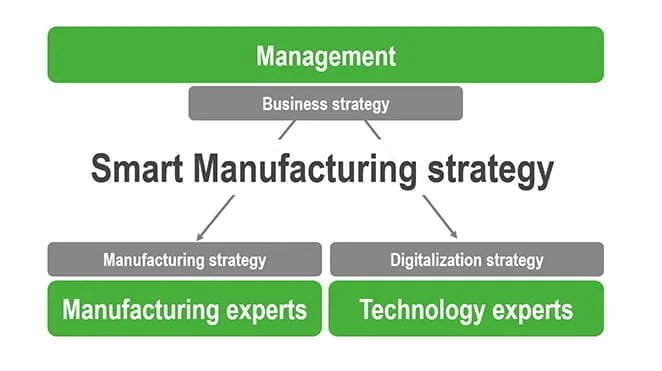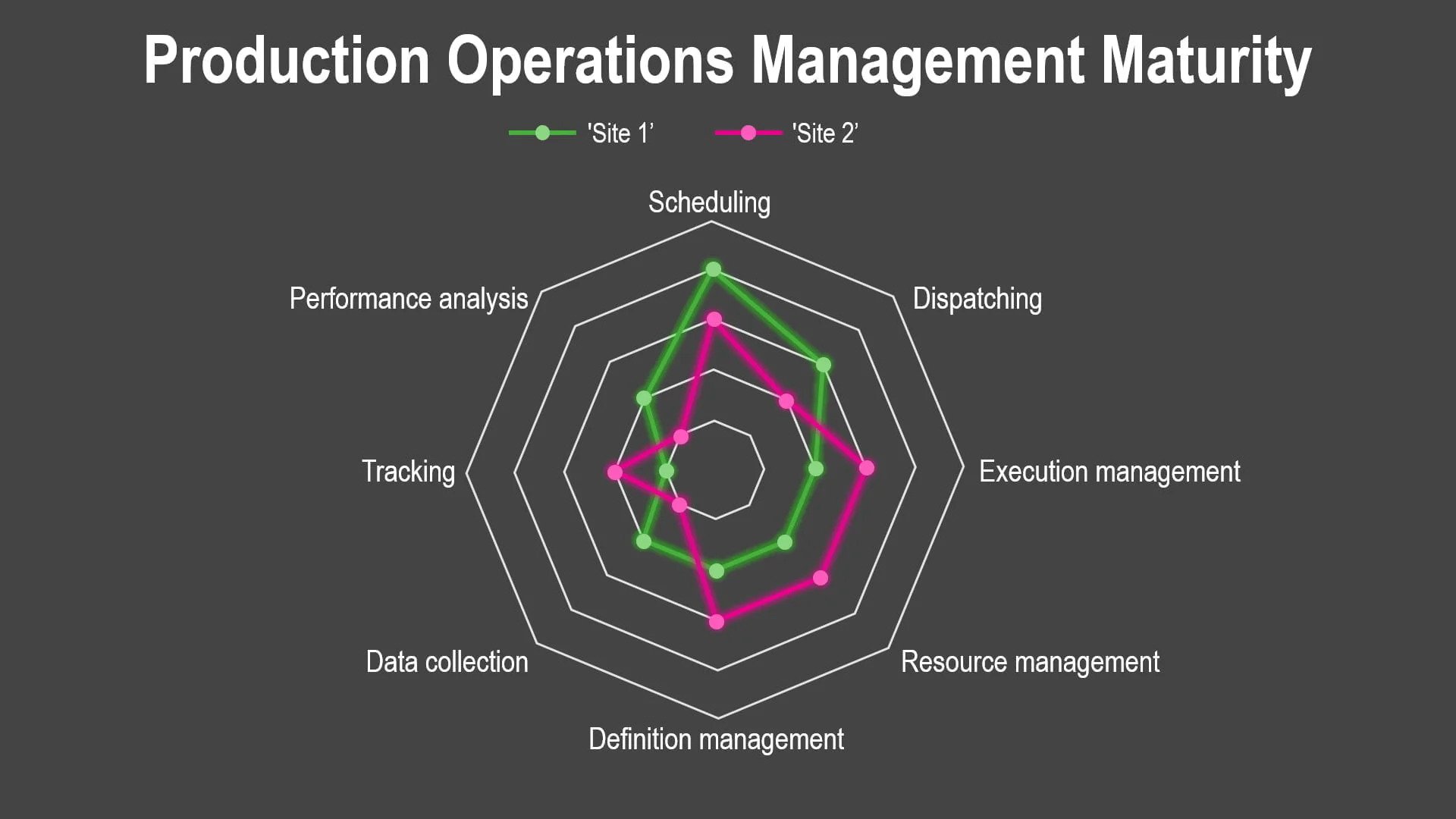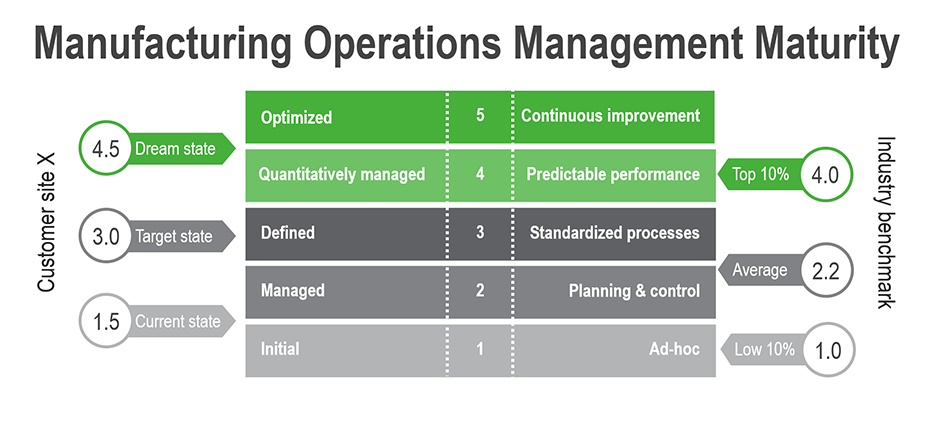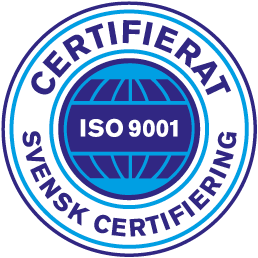Part V: Manufacturing Operations Maturity: Current and Target State Definitions as Part of a Multi-Site MES Program
The success of a Multi-Site MES program requires a company-wide definition of a future state vision that drives the program and digital transformation. This vision is a concrete development plan on which the whole program and multi-site implementation are based.
The development plan should answer to the following questions:
- Why are we implementing a Multi-Site MES?
- Where should we focus our efforts?
- How should we do it?
- What are the objectives?
- What is the route we should drive?
The purpose of this 12-part blog series is to offer you insights and perspectives that should be considered in order to succeed in a Multi-Site MES program. In our previous blog posts, we have provided an overview of some of the basic concepts, standards, and frameworks related to Multi-Site MES programs and discussed the complexity, the financial perspective, and the prerequisites for a Multi-Site MES program.
In this fifth part of our blog series, we will examine the company-wide definition of a current and target state as part of a Multi-Site MES program and the use of a maturity measurement tool to support this process. We will examine these topics from the following perspectives:
- Smart Manufacturing Strategy
- Current state analysis
- Target state definition
- Identification of possible benefits and business case
- Roadmap
1. Why Are We Implementing a Multi-Site MES?
Smart Manufacturing Strategy - Systematic Continuous Improvement
The answer to this question comes from multiple levels of a manufacturing company. The reasons may be small but concrete and visible things, or bigger development needs, but in the end the decision should be based on the thing that drives the business forward: that is, the company or business strategy.
The different dimensions of a company strategy – meaning business strategy, manufacturing strategy, and digitalization strategy – must be based on a shared view of both management and the operational organization on future development. This is called Smart Manufacturing strategy.
To this end, it is crucial that the operational organization possesses a shared awareness of digitalization pressures, an understanding of the current state of operations, and insight into the manufacturing strategy and development plan. The development plan should therefore include development projects for all involved subareas: processes, organization, people, and IT.
Smart Manufacturing, systematic continuous improvement, and excellence in manufacturing operations require investments in processes, organization, people and IT. Developing IT competences or investing in digitalization is not sufficient in itself, as IT is just one of the enablers of those goals.
2. Where Should We Focus Our Efforts?
Current State Analysis - from Site-Specific Challenges to Corporate Vision
In a multi-site manufacturing company, the focus of the MES program should be driven from corporate level but also consider the specific needs of each site. The starting activities should be based on an analysis of the current state of the company’s manufacturing operations, answering to the following questions:
- Do we have standardized and measurable processes in use across all sites?
- Do we have a structure, organization, and roles that support our processes?
- Do we have trained and skilled people with clear roles who execute our processes?
- Do we have IT tools that enable and support the efficient execution of our processes?
From a corporate point of view, the current state analysis should include at least an examination of the current IT landscape, master data management, site comparison possibilities, and metrics, including a review of differences between the sites.
The site-specific analysis should focus on the current issues in manufacturing and on the potential opportunities to improve the manufacturing operations at each particular site. In addition, the current IT landscape and system roles should be defined for each site, focusing on manufacturing operations management activities (ISA-95 level-3 systems). System interfaces for business and automation systems should also be covered to gain an understanding of the complexity and overall architecture of each site.
For a multi-site company, the typical challenges in manufacturing operations are usually related to production control and execution, data collection, quality management, intralogistics, daily management, and performance monitoring. These are the areas that a MES can help to improve significantly. Of course, when analyzing these challenges, you might easily lose focus on the most important thing, as opinions and views may vary greatly depending on who you ask. This is also due to the fact that multi-site manufacturing environments are extremely complex (for more on complexity, see our previous blog post). Therefore, it’s very important that the analysis is done in the same way for all sites and that the organization and the roles of the people taking part in the assignment are mostly the same.
To ease the understanding and complexity of the current state of each site, there are multiple different tools and best practices that can be utilized for the work. A useful and recommended method is to use a maturity model to measure the sites and manufacturing operations in different dimensions (i.e. IT, processes, organization, and people, respectively) and defined maturity levels, typically from 1 to 5. The used tool may be the company’s own tool, or a publicly available standards-based tool (based on industry standards, such as ISA-95). The standards-based tools can be a good starting point to develop your own company-specific maturity analysis tool if you don’t have one yet. By using a maturity tool, you can set your sites to the same level, visualize different focus areas, and bring some clarity into the complexity of multi-site environments.
By using standards-based, ready-made maturity tools and the available expertise of consulting companies, you can:
- Make the current and target state definitions faster and easier to update
- Define the development steps needed for your systems, processes, and organization
- Enable benchmarking
The site-specific analysis and maturity measurement are perfect tools to define the corporate view on what the focus areas should be, and also important tools for developing even other areas than the MES system. The corporate view on the current state should include at least the following items:
- Definition of the scope of the analysis
- Summary of the focus areas and requirements of the different sites with maturity measurements to support the analysis
- Corporate IT landscape and master data management, including differences between the sites.
3. How Should We Do It?
Target State Definition - Maturity Level Increase in Selected Focus Areas
The current state analysis is a good baseline for setting the target state and requirements for a Multi-Site MES. The target state should be created based on the maturity level increase in the selected focus areas and prioritized by estimated business benefits. A maturity tool should also be used to define the target state (short-term objective) and a “dream” state (long-term objective).
A maturity tool can also be used for benchmarking purposes to compare site maturity to similar competitor environments, both in the same industry as well as in entirely different industries. Benchmarking is a good way to identify and assess possible gaps and to broaden your view on what is actually important in your environment. Of course, in order to do the benchmarking, you need knowledge of one or more competitor environments, so the easiest and most effective way is to ask a consulting company to do the job for you.
4. What Are the Objectives?
Prioritization - Identification of Possible Benefits and Business Case
By analyzing the current state of manufacturing operations and digitalization and by setting target states for these, it is possible to define clear, practical steps toward the actual implementation (development areas). However, it should be noted that, as mentioned earlier, the development areas should cover not only IT, but also processes, organization, and employees. All the steps should be driven by the objectives set in the Smart Manufacturing strategy with identified benefits and be measured by maturity level increase. From these individual development areas, it is easy to launch development projects that are tied to the business case.
For more on benefits identification and business case creation, see our earlier blog post “Manufacturing IT financials”.
5. What Is the Road We Should Drive?
Multi-Site MES Roadmap - a Concrete Plan
From the development steps, a concrete plan – a roadmap – should be devised for the future development of the company’s manufacturing operations and sites.
img
A Multi-Site MES Roadmap is the guiding document for a Multi-Site MES implementation, which should cover at least the following topics:
- Objectives: Smart Manufacturing Strategy
- Current state summary: processes, challenges, IT landscape and system roles
- Future state definition: process standardization, IT landscape and system roles, scope, requirements, benefits
- Development plan: phasing, including the scope and a high-level schedule
- Roadmap update and measurement of achieved benefits
The Roadmap is the first concrete “springboard” for MES implementation, an important input for defining the scope of the system, and a crucial part of the Multi-Site MES program execution. The roadmap should be followed and updated regularly throughout the execution of the different development phases, and for that reason, it is also important to define a clear ownership for the document. The roadmap document is not a project plan or system specification, but instead a high-level plan, description, and justification for a Multi-Site MES system. So, for example, in the event of specific problems in the project, the document should thus help you to understand and justify your actions and decisions, and should also be updated upon need.
Conclusions
A Multi-Site MES program is a long journey, and the system to be implemented will be complex. This means that we should invest in the planning of the program and carefully define why to do it, how to do it, and when to do it. A good Multi-Site MES Roadmap will answer to these questions and make the way forward easier and more concrete.














